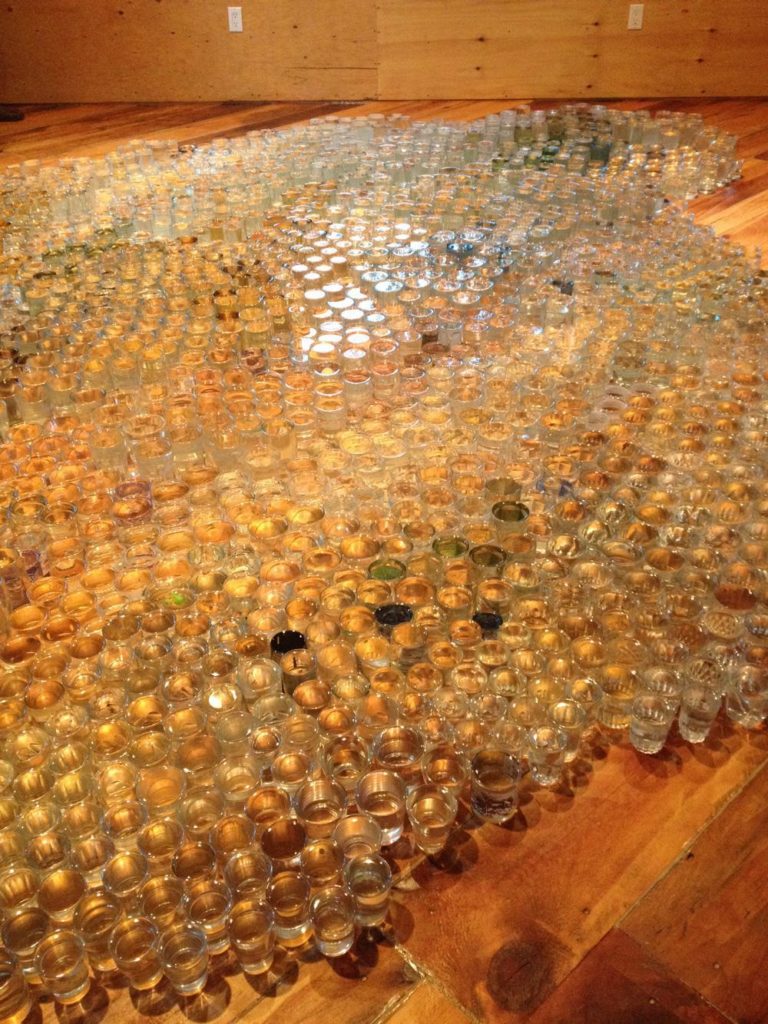After having been moored to the concrete, construction-riddled confines of the city for an entire summer, a field trip to a rural art-destination was a welcome reprieve. So on August 23, myself and 80-plus other city-dwellers and friends took a yellow school bus to Warkworth, Ontario, for the launch of a 16-day art festival there.
Sunday Drive Art Projects organized this event in collaboration with several artist-run-centres, organizations and collectives, populating Warkworth’s small arteries and sprawling across idyllic swaths of the town. This re-contextualization of works from an urban to a rural backdrop—some for just one evening of performance, others for an extended installation period—creates surprising, unlikely and at times unique connections among the various projects, as well as between the works and the town itself.
Perhaps most poetically indicative of this is Karen Abel’s Riffle Pool Riffle {Mill Creek}. The work, presented by Toronto’s Gladstone Hotel, is an expansive and mesmerizing installation of thousands of water-filled glasses arranged on the fragrant wooden floorboards of a refurbished barn. The contained water, taken from the nearby Mill Creek, quivers and dances in response to visitors’ footsteps, subtle earthly vibrations and slight architectural shifts, evoking the undulating movements of the waterway outside. Variations in colours of glasses and hues of water engenders a cartographic impression. Here, an invented (or perhaps accidental) iteration of Warkworth’s topography is drawn using the vital stuff of any town or city: water.
While not described as explicitly eco-political in nature, Riffle Pool Riffle {Mill Creek} conjures thoughts of the increasingly contentious role that water plays today. Bottled water is now trusted over that which comes from the tap; industry-driven dismantling of federal river- and lake-protection legislation sees our waters vulnerable and at risk; and these risks result in the wholesale ruination of water sources that had hitherto sustained rare ecosystems and many communities, particularly those of First Nations. Not unlike Roni Horn’s Library of Water (Vatnasafn) in Stykkishólmur, Iceland, or Rebecca Belmore’s recent gathering around Ayum-ee-aawach Oomama-mowan: Speaking to Their Mother on Toronto’s waterfront, Riffle Pool Riffle {Mill Creek} compels one to contemplate the precarity of our most valuable and essential resource.
Further upstream, Matt Greenwood’s one-night installation Assembly #1 used the concrete creek overpass as a projection surface. Relying on a partial collaboration with technology, the project requires Greenwood to relinquish some of his authority and allow computer-generated imagery to co-exist with his own artistic production. The morphing black and white projection is an astute consideration of our increasingly dependent relationship with technology. Viewed in the city, this work might be lost in the clamor of such digitally mediated environments—however, as a friend pointed out, in Warkworth, it stands in stark contrast to its natural surroundings and is perhaps more effective for it.
Continuous with the impetus to query our relationships with technology was Oliver Pauk and Michael Vickers’s Spectra Logic. A series of three-dimensional, mirrored, geometric forms—suspended from trees—physically reflected the installation’s bucolic surroundings, optically situating elements of nature on human-made objects. The same trees became the screen for a projection after dusk, conflating elements of artificial materiality with the stuff of nature. During the evening, digital imagery seemed to melt into the foliage and bark—occasionally catching a mirror in a wild flare of light—confusing the distinction between the two. While the categories of “human-made” and “naturally occurring” are typically discrete, Spectra Logic (like some recent quantum discoveries) proposed that such categorical borders are instead malleable and not as absolute as we might sometimes assume.
From theoretical divisions to physical ones: Teresa Carlesimo’s Bedrooms and Basements, presented by Art Spin, queries the ways in which walls serve to socially parcel spaces. In creating facsimiles of domestic scenes—ones uncanny in their clean monochromatic performance of, say, a living room—Carlesimo exposes the pared-down form of the many things that serve to create a functional space. The oblique walls, assorted furniture, clustered lamps and vitrine-encased china, all located within the walls of a real Main Street building, provide a sort of voyeuristic opportunity. The installation evokes the intimate places that others navigate, yet in its artificiality, it denies the satisfaction of gleaning an understanding of an actual stranger. This resonates particularly in the context of the festival writ large; inquisitive visitors to Warkworth will likely never satiate their curiosity about everyday lives of those who call the town home.
The evening in Warkworth culminated with Hazel Meyer’s one-night performance Muscle Panic. Framed around “a rogue girl’s basketball team,” the performance, presented by Mercer Union, was staged in the Cow Palace, a high-ceilinged barn that serves as the venue for Warkworth’s Agricultural Fair. The bleachers were full when the basketball team jogged into the barn on Saturday evening, where they proceeded to warm up, practice and prepare the court. Just as Carlesimo’s work resists a feeling of easy resolution, Meyer’s Muscle Panic thwarted the typical anticipation inherent in athletic events. Here, the team avoided playing a game, or even attempting to throw a ball in the hoop. Instead, among other gestures, they re-staged a tender moment from a 2013 WNBA game: a confrontation between two opponents that resulted in a kiss, for which both players were given fouls.
The fastidious self-consciousness of Meyer’s performance, paired with its embrace of some seldom-seen emotive dimensions of sports culture, provided the perfect foil for expectation; in situating things like anxiety, care and failure in the (largely, though not entirely) unlikely spaces of sport, she created a surprising situation where a new context enlivened the things considered. And the productively unexpected outcomes in Meyer’s performance serve as a sort of analogy for the Sunday Drive Warkworth festival; it offers a compelling new backdrop to reconsider things that might otherwise be lost in the cacophony of the city.









